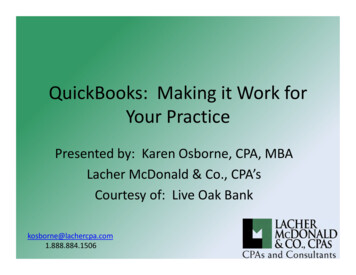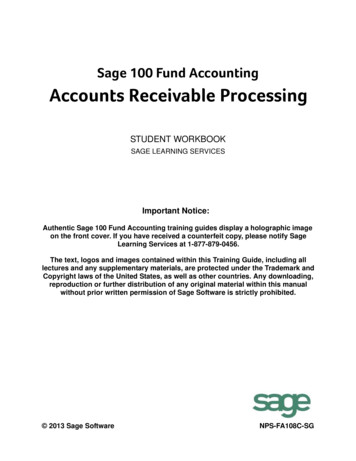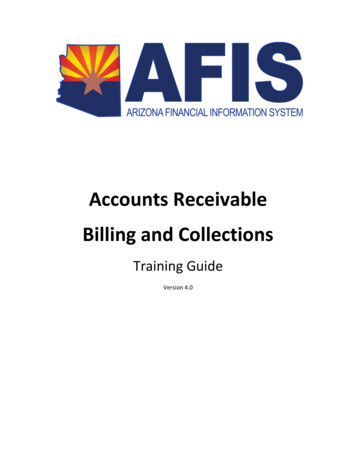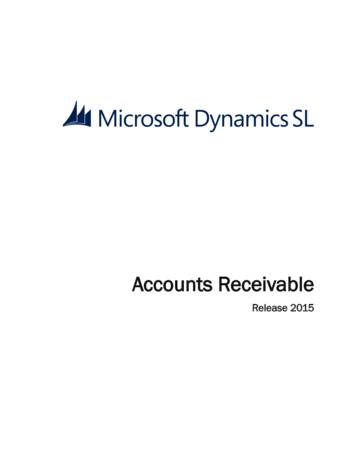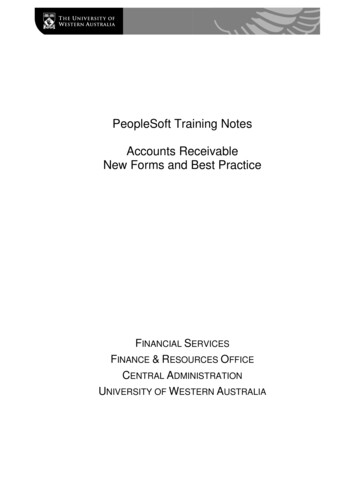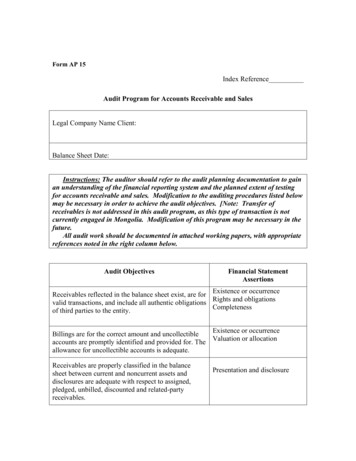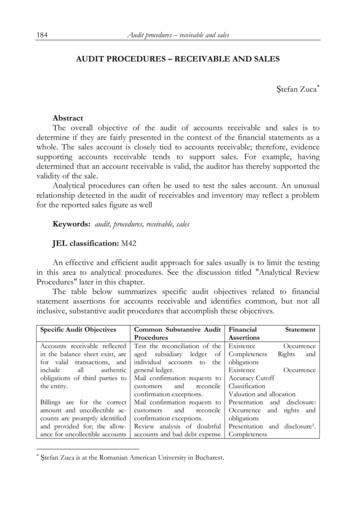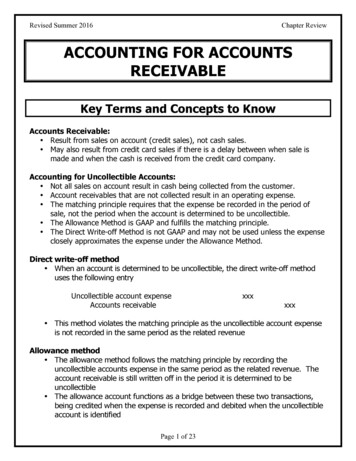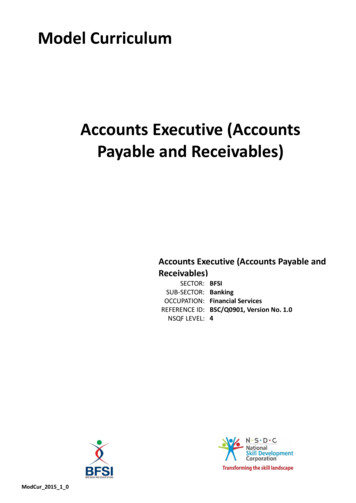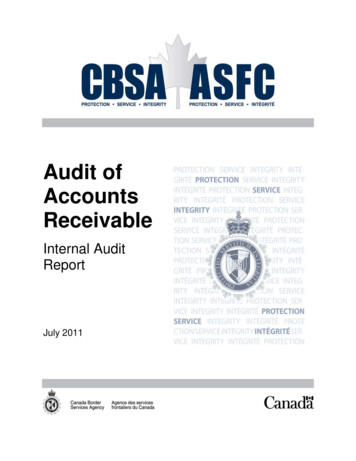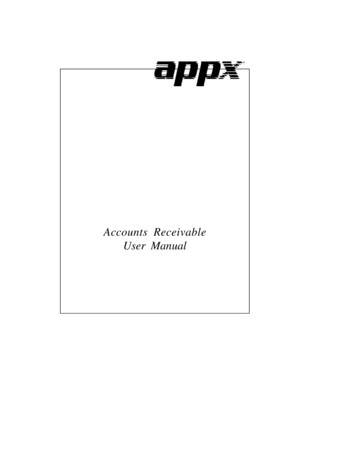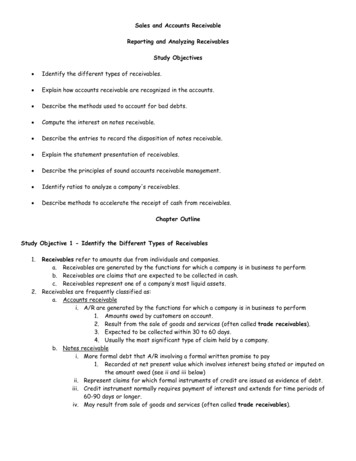
Transcription
Sales and Accounts ReceivableReporting and Analyzing ReceivablesStudy Objectives Identify the different types of receivables. Explain how accounts receivable are recognized in the accounts. Describe the methods used to account for bad debts. Compute the interest on notes receivable. Describe the entries to record the disposition of notes receivable. Explain the statement presentation of receivables. Describe the principles of sound accounts receivable management. Identify ratios to analyze a company's receivables. Describe methods to accelerate the receipt of cash from receivables.Chapter OutlineStudy Objective 1 - Identify the Different Types of Receivables1.Receivables refer to amounts due from individuals and companies.a. Receivables are generated by the functions for which a company is in business to performb. Receivables are claims that are expected to be collected in cash.c. Receivables represent one of a company’s most liquid assets.2. Receivables are frequently classified as:a. Accounts receivablei. A/R are generated by the functions for which a company is in business to perform1. Amounts owed by customers on account.2. Result from the sale of goods and services (often called trade receivables).3. Expected to be collected within 30 to 60 days.4. Usually the most significant type of claim held by a company.b. Notes receivablei. More formal debt that A/R involving a formal written promise to pay1. Recorded at net present value which involves interest being stated or imputed onthe amount owed (see ii and iii below)ii. Represent claims for which formal instruments of credit are issued as evidence of debt.iii. Credit instrument normally requires payment of interest and extends for time periods of60-90 days or longer.iv. May result from sale of goods and services (often called trade receivables).
c.Other receivablesi. Nontrade receivables including interest receivable, loans to company officers, advances toemployees, and income taxes refundable.ii. Generally classified and reported as separate items in the balance sheet.Study Objective 2 - Explain how Accounts Receivable are Recognized in the Accounts1.2.3.4.For a service organization, a receivable is recorded when service is provided on account.Merchandisers record accounts receivable at the point of sale of merchandise on account.Entry is recorded to increase both Sales and Accounts Receivable.Receivable may be reduced by sales discount and/or sales return.Study Objective 3 - Describe the Methods Used to Account for Bad Debts1. Recognition of bad debt expense is about matching the probable bad debt to the period in which the creditsale (that may result in a bad debt) is made.a. This involves estimating bad debts and charging bad debts expense in the period of sale as opposedto the period in which the bad debt becomes apparent due to failure of collection efforts.b. This process involves the use of a “contra” (aka valuation account) called Allowance for Bad Debts inconjunction with the traditional expense account Bad Debts Expensei. Estimated credit losses are debited to Bad Debt Expense (or Uncollectible Accounts Expense)and credited to Allowance for Bad Debts in the period in which the sale occurs.2. The Allowance Method Illustrated:a. The allowance method of accounting for bad debts involves estimating uncollectible accounts at theend of each period.b. Provides for matching of expenses and revenues on the income statement and ensures thatreceivables are stated at their cash (net) realizable value on the balance sheet.c. Cash (net) realizable value is the net amount of cash expected to be received; it excludes amountsthat the company estimates it will not collect.i. That is to say that cash realizable value is equal to A/R less Allowance for Bad Debts (i.e.the net amount of cash expected to be received based on best estimates.d. Receivables are therefore reduced by estimated uncollectible receivables on the balance sheetthrough use of the allowance method.e. The allowance method is required for financial reporting purposes when bad debts arematerial. It has three essential features:i. Uncollectible accounts receivable are estimated and matched against sales in the sameaccounting period in which the sales occurred.ii. Estimated uncollectibles are recorded as an increase to Bad Debts Expense and an increaseto Allowance for Doubtful Accounts (a contra asset account) through an adjusting entry atthe end of each period.iii. Actual uncollectibles are debited to Allowance for Doubtful Accounts and credited toAccounts Receivable at the time the specific account is written off as uncollectible.3. Important characteristics to understand about the Allowance Method:a. Allowance for Doubtful Accounts shows the estimated amount of claims on customers that areexpected to become uncollectible in the future.b. The credit balance in the allowance account will absorb the specific write-offs when they occur.c. Allowance for Doubtful Accounts is a “real (balance sheet) account” is not closed at the end of thefiscal year.d. Bad Debts Expense is reported in the income statement as an operating expense.e. Each write-off should be approved in writing by authorized management personnel.
f.Under the allowance method, every bad debt write-off is debited to the allowance account andnot to Bad Debt Expense.i. Note: The result of this system is that a write-off (i.e. the process of officially recognizingand recording a bad debt) affects only balance sheet accounts.ii. Cash realizable value in the balance sheet, therefore, remains the same.g. When a customer pays after the account has been written off, two entries are required:i. The entry made in writing off the account is reversed to reinstate the customer’s account.ii. The collection is journalized in the usual manner.h. The recovery of a bad debt, like the write-off of a bad debt, affects only balance sheet account.Illustrating the Allowance Method or Recognizing Bad DebtsAssume Hampson Furniture has credit sales of 1,200,000 in 2004, of which 200,000 remains uncollected at December 31. Thecredit manager estimates that 12,000 of these sales will prove uncollectible. The adjusting entry to record the estimateduncollectibles is:Dec. 31Note that the expense is recognized in theperiod that the sale took place and that the“contra” account Allowance for BD is used tocreate a “net” value for A/RBad Debts Expense12,000Allowance for Doubtful Accounts12,000(To record estimate of uncollectible accounts)Bad Debt Expense is a selling expense. This entry has no effect on cash flows. The Allowance for Doubtful Accounts is a contra assetaccount and is shown on the balance sheet as a reduction from accounts receivable. Therefore Hampson's balance sheet would reportaccounts receivable as follows:Accounts receivableLess: Allowance for doubtful accounts 200,00012,000 188,000Assume that the vice-president of finance of Hampson Furniture on March 1, 2005, determines that a 500 balance owed by R. A.Ware will not be collected. The entry to record the write-off is:Note that the “write-off” has no effect oneither the Income Statement (no expense orMar. 1Allowance for Doubtful Accounts500revenue account is affected) or the balanceAccounts Receivable—R. A. Ware500sheet (the net value of A/R) remains(Write-off of R. A. Ware account)unchanged at 188,000.Notice, the bad debt was written off to the allowance account not to the Bad Debts Expense account. Therefore, the write-off doesnot affect net income, nor does it affect net assets.Accounts receivableAllowance for doubtful accountsCash realizable valueBefore Write-off 200,00012,000 188,000After Write-off 199,50011,500 188,000If R. A. Ware pays Hampson the 500, two journal entries are required to record the collection:July 1July 1Accounts Receivable—R. A. Ware500Allowance for Doubtful Accounts(To reverse write-off of R. A. Ware account)Cash500Accounts Receivable—R A. Ware(To record collection from R. A. Ware)500If customer eventually pays, two steps arenecessary:1.Reinstate the receivable2.Record the receipt of cash500Accounts Receivable and the Allowance for Doubtful Accounts both increase in entry (1) for two reasons: First the company made anerror in judgment when it wrote off the account receivable. Second, R. A. Ware did pay, and therefore the Accounts Receivableaccount should show this collection for possible future credit purposes.
1.How do companies determine the proper value for the “Allowance for Bad Debts”?a. In “real life,” companies must estimate the amount of expected uncollectible accounts if they usethe allowance method. There are two common methods employed for the estimation of uncollectibleaccounts (bad debts).i. The Balance Sheet approach:1. The percentage of receivables basis: management establishes a percentagerelationship between the amount of receivables and expected losses fromuncollectible accounts.a. A schedule is prepared in which customer balances are classified by thelength of time they have been unpaid.b. Because of its emphasis on time, this schedule is often called an agingschedule, and the analysis of it is often called aging the accountsreceivable.i. After the accounts are arranged by age, the expected bad debtlosses are determined by applying percentages, based on pastexperience, to the totals of each category.1. For example:a. 0-30 days95%b. 31-60 days80%c. 60-90 days70%d. Over 90 days 60%c. The estimated bad debts represent the existing customer claims expectedto become uncollectible in the future.i. This amount represents the required balance in Allowance forDoubtful Accounts at the balance sheet date.ii. Accordingly, the amount of the bad debts adjusting entry is thedifference between the required balance and the existing balancein the allowance account.iii. Occasionally the allowance account will have a debit balance prior toadjustment because write-offs during the year have exceededprevious provisions for bad debts.1. In such a case, the debit balance is added to the requiredbalance when the adjusting entry is made.4. Direct write-off method (only GAAP when receivables are immaterial in amount)a. While the “Allowance Method” is the only GAAP method for businesses with material amounts ofA/R, those businesses with only minor (immaterial) A/R can use the Direct Charge (aka DirectWrite-Off) method.b. Application of the Direct Write-Off (Direct Charge) methodi. When a specific account is determined to be uncollectible, the loss is charged to Bad DebtExpense.c. Direct Charge method illustrated:Assume that Warden Co. writes off M. E. Doran’s 200 balance as uncollectible on December 12. The entry is:Dec. 12Bad Debts Expense200Accounts Receivable--M. E. Doran200(To record write-off of M. E. Duran account)Note:1. Bad debts are written of only when the determination is madethat they are uncollectible.2. There is no attempt to match the bad debt expense to therevenue that created it (the matching principal is violated).
d. Problems created by the Direct Charge method:i. Bad debts expense is often recorded in a period different from that in which the revenuewas recorded (violation of matching principal).ii. No attempt is made to show accounts receivable in the balance sheet at the amount actuallyexpected to be received (violation of full disclosure).iii. Use of the direct write-off method can reduce the usefulness of both the incomestatement and balance sheet.e. Why is the Direct Charge method allowed at all?i. Proponents argue that because receivables are immaterial, the Direct Charge method cancause no material differences in the values presented in the financial statementsii. Ease of useStudy Objective 4 - Compute the Interest on Notes Receivable1.Characteristics of promissory notes:a. A promissory note is a written promise to pay a specified amount of money on demand or at adefinite time.b. In a promissory note, the party making the promise to pay is called the maker.c. The party to whom payment is to be made is called the payee.i. The payee may be specifically identified by name or may be designated simply as the bearerof the note.d. Notes receivable give the holder a stronger legal claim to assets than accounts receivable.e. Notes receivable are frequently accepted from customers who need to extend the payment of anoutstanding account receivable, and they are often required from high-risk customers.f. Like accounts receivable, notes receivable can be readily sold to another party.g. Promissory notes are negotiable instruments.2. Accounting for notes receivable:a. Notes must have three components:i. Makerii. Payeeiii. Due date (or on demand)b. All notes must have an interest component but that interest component may be either stated orimputed.i. If there is no interest amount stated on the note, interest must be “imputed” and the rateapplicable to the maker based on the makers’ credit worthiness.3. Interest on Notes Receivable:a. The formula for computing interest is (PxRxT):i. Face Value of Note (principle) x Annual Interest Rate x Time (in terms of one year)ii. Interest is normally stated on a per annum basis and therefore the formula must be appliedon a per annum basis (i.e. 3 months ¼ year)1. The interest rate specified on the note is an annual rate of interest. The timefactor in the computation expresses the fraction of a year that the note isoutstanding.iii. Determining the Maturity date: When the maturity date is stated in days, the time factor isfrequently the number of days divided by 360. For example, the maturity date of a 60-daynote dated July 17 is determined as follows:Term of noteJuly31 daysDate of note17Remaining days in July: 14August31Maturity date, September60 days4515
Remembering the Number of Days in a Given Month30 days hath September, April, June, and November.All the rest have 31, save February which has 28,except in leap year when it has 29.Interest Computations IllustratedTerms of Note 730, 18%, 120 days 1,000, 15%, 6 months 2,000, 12%, 1 yearAlthough many financial institutionsdays.Interest Computation 730 x 18% x 120/360 43.80 1,000 x 15% x 6/12 75.00 2,000 x 12% x 1/1 240.00use 365 days in computing interest, problems in the text assume 3604. Accounting Entries for Notes Receivable:a. To illustrate the basic entry for notes receivable, the text uses Brent Company’s 1,000, twomonth, 12% promissory note dated May 1. Assume that the note was written to settle an openaccount. The entry for the receipt of the note by Wilma Company is as follows:May 1Notes Receivable1,000Accounts Receivable—Brent Company.(To record acceptance of Brent Company note)1.2.3.4.1,000The note receivable is recorded at its face value, the value shown on the face of the note.No interest revenue is reported when the note is accepted because the revenue recognition principle does not recognizerevenue until earned. Interest is earned (accrued) as time passes.If a note is exchanged for cash, the entry is a debit to Notes Receivable and a credit to Cash in the amount of the loan.Like accounts receivable, short-term notes receivable are reported at their cash (net) realizable value.5. The notes receivable allowance account is Allowance for Doubtful accounts.Study Objective 5 - Describe the Entries to Record the Disposition of Notes Receivable1. A note is honored when it is paid in full at maturitya. If notes are held to their maturity date, both the face value of the note plus accrued interest mustbe recorded.Accounting for an honored note paid in full at maturityAssume that Wolder Co. lends Higley, Inc. 10,000 on June1, accepting a 4-month, 9% interest note. If Wonderpresents the note to Higley Inc. on October 1, the maturitydate, the entry by Wolder to record the collection is:Oct. 1Cash10,300Notes Receivable10,000Interest Revenue300*(To record collection of Higley Inc. note and interestIf Wolder prepares financial statements as of September30, the following adjusting entry would be made to accrueinterest revenue.Sept. 30Interest Receivable300Interest Revenue300(To accrue 4 months' interest on Higley note)When interest has been accrued, the entry to record thehonoring of Higley's note on October 1 is:Oct. 1* 10,000 x .09 x 4/12 300Cash10,300Notes ReceivableInterest Receivable(To record collection of note at maturity)10,000300
2. A dishonored note is a note that is not paid in full at maturity.a. If the maker of the note defaults or if the note is not paid in full at the maturity date (or ondemand in the case of a demand note) the note is considered dishonored, two options are possible:i. If the lender expects that it will eventually be able to collect, the Notes Receivable accountis transferred to an Account Receivable for both the face value of the note and theinterest due.ii. If there is no hope of collection, the face value of the note should be written off.Study Objective 6 - Explain the Balance Sheet Presentation of Receivables1. Receivables are “Real Accounts” presented on the balance sheet in order of liquidity.2. Each of the major types of receivables should be identified in the balance sheet or in the notes to thefinancial statements.a. Short-term receivables (other than Accounts Receivable) are reported in the current asset sectionof the balance sheet below short-term investments.b. Both the gross amount of receivables and the allowance for doubtful accounts should be reported.c. Notes receivable are listed before accounts receivable because notes are more easily converted tocash.d. Bad Debts Expense is reported under “Selling expenses” in the income statement.e. Interest Revenue is shown under “Other Revenues and Gains” in the non-operating section of theincome statement. Note: If a company has significant risk of uncollectible accounts or other problems with receivables, it is requiredto discuss this possibility in the notes to the financial statements.The advantages of having a note receivable rather than an account receivable are that:1.Notes earn interest.2.Notes receivable give the holder a stronger legal claim to assets than accounts receivable.3.A note is a negotiable instrument and may be transferred to another party by endorsementStudy Objective 7 - Describe the Principles of Sound Accounts Receivable Management1. Managing accounts receivable involves five steps:a. Determine to whom to extend credit.i. Risky customers might be required to provide letters of credit or bank guarantees.ii. Risky customers might be required to pay cash on delivery.iii. Ask potential customers for references from banks and suppliers and check the references.iv. Periodically check financial health of continuing customers.b. Establish a payment period.i. Determine a required payment period and communicate that policy to customers.ii. Make sure company's payment period is consistent with that of competitors.c. Monitor collections.i. Prepare accounts receivable aging schedule at least monthly.ii. Pursue problem accounts with phone calls, letters, and legal action if necessary.d. Evaluate the receivables balance.i. If a company has significant concentrations of credit risk, it is required to discuss this riskin the notes to its financial statements.1. A concentration of credit risk is a threat of nonpayment from a single customer orclass of customers that could adversely affect the financial health of the company.e. Accelerate cash receipts from receivables when necessary. (see study objective 9 below)i. Many companies offer terms (2/10 net 30 etc) to accelerate payment by creditors.All these steps are superfluous if the credit/collections department is not staffed with competent personnel
Study Objective 8 - Identify Ratios to Analyze a Company's Receivables1. Liquidity is measured by how quickly certain assets can be converted into cash.a. The ratio used to assess the liquidity of the receivables is the receivables turnover ratio.i. The ratio measures the number of times, on average; receivables are collected during theperiod.ii. The receivables turnover ratio is computed by dividing net credit sales (net sales less cashsales) by the average gross accounts receivables during the year.b. A popular variant of the receivables turnover ratio is to convert it into an average collection periodin terms of days. This is computed by dividing the receivables turnover ratio into 365 days.Consider the following computations of Mckesson's receivables turnover ratio for 2000 and 2001:20012000Net Credit SalesAverage Gross Receivables 42,010( 3,863.1 3,309.4)/2365/11.7 31.2 daysNet Credit SalesAverage Gross Receivables 11.7 36,687( 3,309.4 2,732.6)/2 12.1365/12.1 30.2 daysStudy Objective 9 - Describe Methods to Accelerate the Receipt of Cash from Receivables1. Two common expressions apply to the collection of receivables:a. Time is money—that is, waiting for the normal collection process costs money.b. A bird in the hand is worth two in the bush—that is, getting the cash now is better than getting itlater or not at all.2. Methods to Accelerate payment of receivables by creditors:a. Offer Terms (Sales discounts)for quick payment of goods (2/10, net 30)i. Known as sales discounts, these terms allow the creditor to take a 2% discount if thereceivable is paid in the first 10 days of the month. Failure to take the discount costs thepurchaser 36% on an annualized basis and is often an effective stimulus to generate rapidpayment by creditors.ii. There are three reasons for the sale of receivables.b. Sell receivables: In recent years, for competitive reasons, sellers (retailers, wholesalers, andmanufacturers) often have provided financing to purchasers of their goods. This process hasgenerated increased sales but retarded the collection of cash.i. Receivables may be sold because they may be the only reasonable source of cash.When credit is tight, companies may not be able to borrow money in the usual creditmarkets.ii. Another reason for selling receivables is that billing and collection are often timeconsuming and costly. As a result, it is often easier for a retailer to sell the receivables toanother party that has expertise in billing and collection matters.1. A common way to accelerate receivables collection is a sale to a factor.a. A factor is a finance company or a bank that buys receivables frombusinesses for a fee and then collects the payments directly from thecustomers.
b. Factoring arrangements vary widely, but typically the factor charges acommission of 1% to 3%.Illustrating the Process of Factoring a ReceivableAssume Hendredon Furniture factors 600,000 of receivables to Federal Factors, Inc. Federal Factors assesses aservice charge of 2% of the amount of receivables sold. Hendredon makes the following journal entry:Cash588,000Service Charge Expense (2% x 600,000)12,000Accounts Receivable600,000(To record the sale of accounts receivable)The service charge expense is recorded as a selling expense.2. A retailer’s acceptance of a national credit card is another form of selling—factoring—the receivable by the retailer.a. Approximately one billion credit cards were estimated to be in use recently.A common type of credit card is a national credit card such as Visa andMasterCard.b. Three parties are involved when national credit cards are used in makingretail sales:i. The credit card issuer, who is independent of the retailer,ii. the retailer, andiii. the customer.c. There are several advantages of credit cards for the retailer:i. Issuer does credit investigation of customer.ii. Issuer maintains customer accounts.iii. Issuer undertakes collection process and absorbs any losses.iv. Retailer receives cash more quickly from credit card issuer.3. Sales resulting from the use of Visa and MasterCard are considered cash sales bythe retailer. Upon receipt of credit card sales slips from a retailer, the bank thatissued the card immediately adds the amount to the seller’s bank balance. To illustrate, Morgan Marie purchases 1,000 of compact discs for her restaurant from Sondgeroth Music Co.,and she charges this amount on her Visa First Bank Card. The service fee that First Bank charges SondgerothMusic is 3 percent. The entry by Sondgeroth Music to record this transaction is:Cash970Service Charge Expense30Sales(To record Visa credit card sales)1,000
Sales and Accounts Receivable Review9What are the different types of receivables? Why is it necessary to have them in different categories?9Explain how accounts receivable are recognized in the accounts.9What are the two methods used to account for bad debts? Which method is required by GAAP if bad debts arematerial?9How is bad debt estimated when using the allowance method?9What is the formula for computing interest on notes receivable?9Describe the entries to record the disposition of notes receivable.9Explain the statement presentation of receivables.9What are the five steps in managing accounts receivable?9Identify and compute ratios to analyze a company's receivables.9What methods are used to accelerate the receipt of cash from receivables?
Reading Comprehension Check INameSales and Accounts ReceivableThe term refers to amounts due from individuals and companies. areclaims that are expected to be collected in cash. The management of is a very important activityfor any company that sells goods on . Receivables are important because they represent one of acompany's most . For many companies receivables are also one of the largest.The relative significance of a company's as a percentage of its differsdepending on its industry, the time of year, whether it extends long-term financing, and its. To reflect important differences among receivables, they are frequently classified as (1), (2) , and (3) .are amounts owed by customers on account. They result from theof and . These receivables generally are expected to becollected within to days. They are the most significant type of claim held bythe company.represent claims for which formal instruments of credit are issuedas evidence of the . The credit instrument normally requires the debtor to payand extends for time periods of to days or longer. Notes and accountsreceivable that result from sales transactions are often called .
Solutions to Reading Comprehension Check ISales and Accounts ReceivableThe termrefers to amounts due from individuals and companies. Receivablesreceivablesclaims that are expected to be collected in cash. The management of receivablesfor any company that sells goods oncompany's mostlargestcreditliquidis a very important activity. Receivables are important because they represent one of aassetsassetsare. For many companies receivables are also one of the.The relative significance of a company'sreceivablesas a percentage of itsassetsdiffersdepending on its industry, the time of year, whether it extends long-term financing, and its creditpolicies, (2). To reflect important differences among receivables, they are frequently classified as (1)notes, and (3)Accountssaleofreceivablegoodscollected withinother30.are amounts owed by customers on account. They result from theandtoaccountsservices60. These receivables generally are expected to bedays. They are the most significant type of claim heldby the company.Notesissued as evidence of theinterestreceivabledebtand extends for time periods ofrepresent claims for which formal instruments of credit are. The credit instrument normally requires the debtor to pay60toaccounts receivable that result from sales transactions are often called90tradedays or longer. Notes andreceivables .
Reading Comprehension Check IINameSales and Accounts ReceivableCredit may also be granted in exchange for a formal credit instrument known as a. A promissory note is a written promise to pay a specified amount of money onor at a.Promissory notes may be used when (1) individuals andcompanies or money, (2) when the amount of the transaction and the creditperiod exceed, and (3) in settlement of.In a promissory note, the party making the promise to pay is called the ; the party to whompayment is to be made is called the . The payee may be specifically identified by name or may bedesignated simply as the of the .Notes receivable give the holder a stronger tothan . Like accounts receivable,can be readily sold to another party. Promissory notes are (as are checks)which means that, when sold, they can be to another party by .Notes receivable are frequently accepted from customers who need to extend the payment of an outstandingand are often required from high-risk customers.
Solutions to Reading Comprehension Check IISales and Accounts ReceivableCredit may also be granted in exchange for a formal credit instrument known as anotepromissory. A promissory note is a written promise to pay a specified amount of money on demandor at adefinitelendtimeornormalborrowlimits. Promissory notes may be used when (1) individuals and companiesmoney, (2) when the amount of the transaction and the credit period exceed, and (3) in settlement of accountsreceivableIn a promissory note, the party making the promise to pay is called thepayment is to be made is called thedesignated simply as thepayeebearerof theNotes receivable give the holder a strongernotereceivablecan be readily sold to another party.endorsement.legalthaninstruments; the party to whom. The payee may be specifically identified by name or may beassetsaccountsmaker.receivableclaimto. Like accounts receivable,notesPromissory notes are(as are checks) w
Receivables refer to amounts due from individuals and companies. a. Receivables are generated by the functions for which a company is in business to perform b. Receivables are claims that are expected to be collected in cash. c. Receivables represent one of a company's most liquid assets. 2. Receivables are frequently classified as: a.

